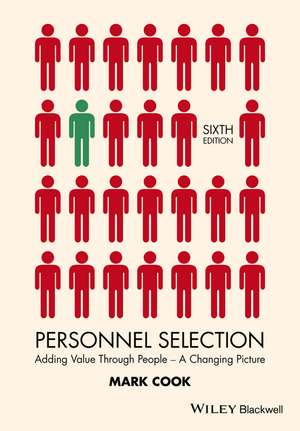Personnel Selection – Adding Value Through People – A Changing Picture 6e
Autor M Cooken Limba Engleză Hardback – 31 mar 2016
- Focuses on cutting–edge topics including the influence of social networking sites, adverse impact, age differences and stereotypes, distribution of work performance, and the problems of selecting new employees using research based on incumbent employees
- Questions established beliefs in the field, especially issues that have been characterized as not a problem, such as differential validity, over–reliance on self–report, and faking good
- Contains expanded discussion of research and practice in the US and internationally, while maintaining the definitive coverage of UK and European selection approaches
- Provides comprehensive yet accessible information for professionals and students, as well as helpful pedagogical tools (technical and statistical boxes, simplified figures and tables, research agenda boxes, key point summaries, and key references)
Preț: 502.36 lei
Preț vechi: 742.79 lei
-32% Nou
96.13€ • 102.79$ • 80.15£
Carte indisponibilă temporar
Specificații
ISBN-10: 1118973593
Pagini: 368
Dimensiuni: 176 x 239 x 23 mm
Greutate: 0.7 kg
Ediția:6th Edition
Editura: Wiley
Locul publicării:Chichester, United Kingdom
Public țintă
Graduate students and upper–level undergraduates taking courses in occupational and organizational psychology, human resource management, management, and selection in departments of psychology, business and management, and human resources; practitioners and selection specialists working in human resources management and industrial–organizational psychology; also trainees in workplace psychological testingCuprins
Preface to the sixth edition vii
Preface to the first edition ix
1 Old and new selection methods 1
We ve always done it this way
2 Validity of selection methods 25
How do you know it works?
3 Job description, work analysis and competences 55
If you don t know where you re going, you ll end up somewhere else
4 The interview 71
I know one when I see one
5 References and ratings 94
The eye of the beholder
6 Tests of mental ability 110
a man of paralysing stupidity
7 Assessing personality by questionnaire 138
Do you worry about awful things that might happen?
8 Alternative ways of assessing personality 173
What year was the Bataan death march?
9 Biodata and weighted application blanks 192
How old were you when you learned to swim?
10 Assessment centres 207
Does your face fit?
11 Emotional intelligence and other methods 227
Success in work is 80% dependent on emotional intelligence
12 Criteria of work performance 246
the successful employee does more work, does it better, with less supervision
13 Minorities, fairness and the law 268
Getting the numbers right
14 The value of good employees 289
The best is twice as good as the worst
15 Conclusions 307
Calculating the cost of smugness
References 319
Index 348
Descriere
This is a fully updated edition of Personnel Selection, a seminal text on the psychometric approach to personnel selection by a noted expert in the field.
- Focuses on cutting–edge topics including the influence of social networking sites, adverse impact, age differences and stereotypes, distribution of work performance, and the problems of selecting new employees using research based on incumbent employees
- Questions established beliefs in the field, especially issues that have been characterized as not a problem, such as differential validity, over–reliance on self–report, and faking good
- Contains expanded discussion of research and practice in the US and internationally, while maintaining the definitive coverage of UK and European selection approaches
- Provides comprehensive yet accessible information for professionals and students, as well as helpful pedagogical tools (technical and statistical boxes, simplified figures and tables, research agenda boxes, key point summaries, and key references)
